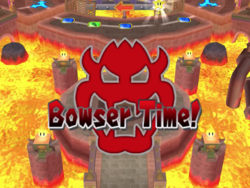Bowser Time
- “It's everyone's favorite time, BOWSER TIME!”
- —Bowser, Mario Party 7
Bowser Time, known in British English as Bowser Party, is an event that appears only in Mario Party 7, occurring every five turns. It happens only in the Party Cruise mode. The gauge always starts at 0% when the game begins, and each turn, after every minigame, the gauge increases by 20%. The process repeats until the gauge is full, at which point Bowser shows up and does something that hinders players, and the gauge resets itself at 0%. When the game winds down to its last four turns, the gauge does not appear or fill up. Depending on the number of turns in a match, Bowser Time may occur only once or up to nine times. The gauge on the screen is Bowser's emblem. In later Mario Party games, such as Mario Party DS and Mario Party 9, landing on a Bowser Space triggers an event called "Bowser Time," but it is more similar to the usual effects of a Bowser Space than the special event from Mario Party 7. Likewise, Mario Party 10 features a gimmick called "Bowser Party"; however, rather than behaving the same as the special event from Mario Party 7, this mechanic focuses on one player playing as Bowser, with others playing as any other character.
Events
Template:More images Bowser can perform any number of events on different boards, as listed below:
| Image(s) | Event | Boards |
|---|---|---|
| File:Nocoverart.png File:Nocoverart.png File:Nocoverart.png File:Nocoverart.png 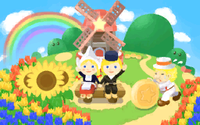
|
Bowser may take a picture of the players and make them pay 10 or 20 coins for it. Occasionally, Bowser "stumbles into" the photo, but this does not affect the cost at all. Either way, Bowser then leaves without giving the players their photograph, which Toadsworth points out to the dejected group. | Grand Canal Pagoda Peak Pyramid Park Neon Heights Windmillville |
File:Nocoverart.png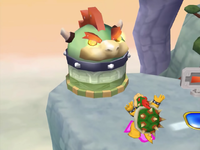 File:Nocoverart.png |
Bowser may take over one of the two Orb huts on the boards until a player passes by, forcibly selling either a Golden Bowser Statue or a Koopa Kid Orb to them for 20 coins (or fewer if the player does not have that much). However, any purchases made at a Bowser-owned Orb shop still count towards the Shopping Star. Afterward, Koopa Kid takes whatever the player was forced to purchase; if it was a Koopa Kid Orb, he throws it onto a random space. If a player approaches Bowser's shop and does not have any coins, Bowser gives the player 10 coins. He does not leave until someone has purchased one of the two items he sells. | Grand Canal Pagoda Peak Pyramid Park |
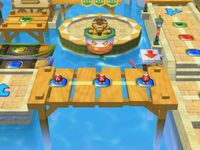 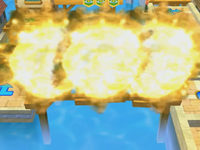  
|
Bowser may destroy the bridges on the board with Bob-ombs via his Koopa Clown Car and build his own bridges with three Bowser Spaces on them, which remain for three turns before becoming normal again. | Grand Canal |
| File:Nocoverart.png | Bowser may slam the mountain, making the players fall down a few spaces. | Pagoda Peak |
| File:Nocoverart.png | Bowser may destroy a bridge for one turn so a player has to cut their turn short if they reach it. | Pagoda Peak |
| File:Nocoverart.png | Bowser may summon a tornadic sandstorm to destroy the bridges spanning the two sides of the board, making players stuck on one side for three turns unless they land on certain Green Spaces. This also destroys the Orb huts for three turns since they are located on the bridges. If any players are on the bridges, they are sent back to the start. | Pyramid Park |

|
Bowser may take a Star away from the player in first place and give it to Koopa Kid, who is somewhere on the board. This Star can then be taken by any player using a Chain Chomp, but Koopa Kid periodically moves his location (like how Bandit does in the Solo Cruise). | Pyramid Park |
| File:Nocoverart.png | Bowser may steal ten coins from each of the players (for a total of 40) and put them in the chest that contains 20 coins, increasing the coin number in that chest to 60. The extra coins remain in the chest until either they are collected or the chest containing a regular Star is opened. | Neon Heights |
| File:Nocoverart.png | Bowser may steal a Star from the player in first place and put it in the chest that contains a Star. One chest, therefore, contains two Stars until it is opened. | Neon Heights |
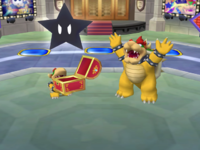
|
Bowser may put a Dark Star in a chest, and the player opening the chest with the Dark Star loses one Star. This replaces the Bob-omb until either the Dark Star is obtained or the chest containing a regular Star is opened. | Neon Heights |
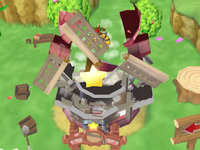
|
Bowser may destroy a windmill (thus erasing any coins the players had invested in it), leading a new "blank" one without any coins being built. | Windmillville |
| File:Nocoverart.png | Bowser may send Koopa Kid to rob one of the windmills. There is a 1% chance that Koopa Kid will fail to steal any coins, which will result in Bowser grounding him. | Windmillville |

|
Bowser always sinks the island with the Star and, with the exception of the first Bowser Time, raises the island that was sunk before it. Players on the sunken island are sent back to the start and lose half of their coins. In Solo Cruise, this happens when the player lands on a Green Space. | Bowser's Enchanted Inferno! |
Gallery
Names in other languages
| Language | Name | Meaning | Notes |
|---|---|---|---|
| Japanese | クッパタイム[?] Kuppa taimu |
Bowser Time | |
| Italian | Ira di Bowser![?] | Bowser wrath! | |
| Spanish (NOE) | ¡La hora de Bowser![?] | Bowser Time! |
Trivia
- When Bowser Time begins, Bowser appears at the beginning of the board, but in Pagoda Peak, he appears on top of the mountain.
